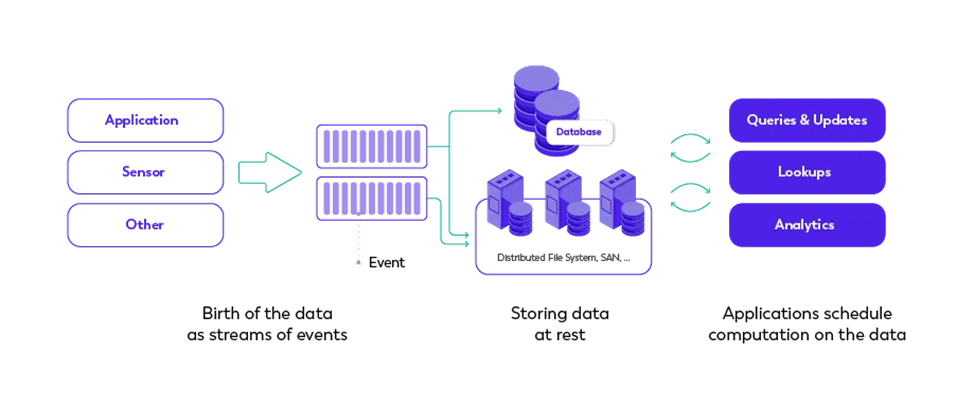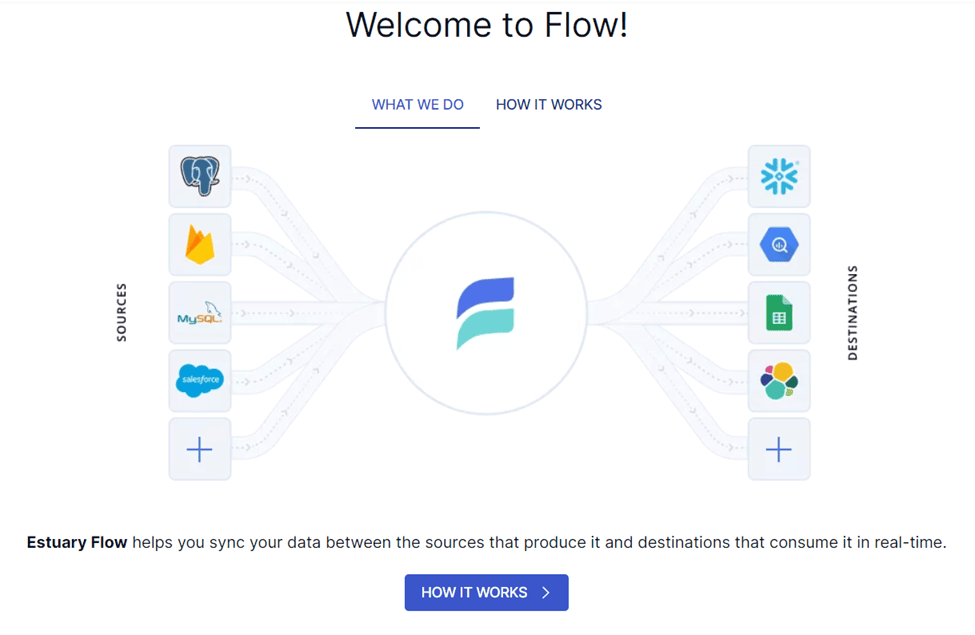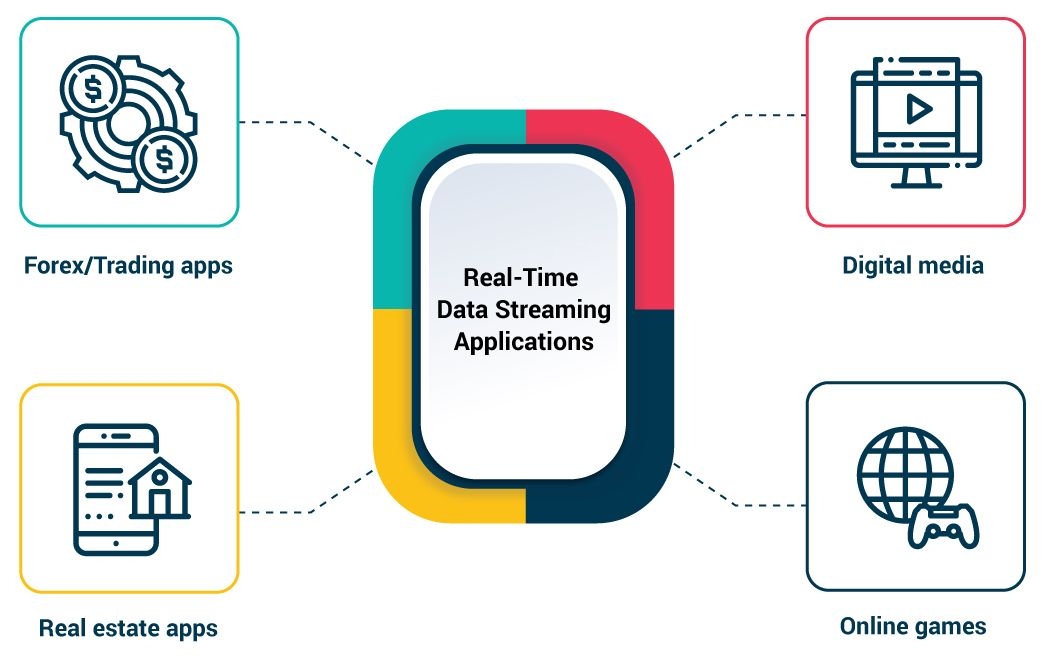Data is generated at an unprecedented rate from IoT sensors, servers, security logs, applications, and mobile phones. Without real-time data streaming technology, it would be impossible to manage the volume and speed of data production, let alone regulate its structure or data integrity.
Unlike traditional solutions that ingest, process, and structure data before it can be acted upon, streaming data architecture allows for consuming, storing, enriching, transforming, and analyzing data as it is generated.
In this article, we will provide a comprehensive understanding of how real-time data streaming works, why it’s important, and how you can leverage it to improve business operations and drive positive outcomes.
After reading this article, you will have a clear understanding of real-time data streaming, the tools and technologies necessary to implement it, and how you can use it to drive better business outcomes, enhance customer experiences, and gain a competitive advantage.
So let’s get started.
What Is Real-Time Data Streaming?
Real-time data streaming is a technology that enables the collection and processing of data from multiple data sources in real time to derive insights and meaning from it. This means that you can analyze data and act upon it as soon as it’s generated, allowing for faster and more informed decision-making.
Real-time stream processing technologies allow companies to process large amounts of continuous data quickly and determine what actions should be taken right away.
It gives you access to detailed information so you can take immediate action on any issues or potential opportunities you may encounter. Real-time streaming also allows you to detect anomalies in your data, which could potentially lead to the discovery of new business opportunities or risks ahead of time.
Traditional solutions are built with the sole purpose of ingesting data before it can be acted upon; however, these systems often lack scalability when dealing with large datasets and require significant manual effort for processing such datasets.
With real-time stream processing technologies, this issue is resolved since they are designed specifically for processing large volumes of rapidly arriving datasets in small chunks as soon as they arrive from the source.
This eliminates any manual effort required for processing such datasets since it automatically processes them as soon as they arrive from the source without any further intervention from a user or engineer.
Real-Time Data Streaming Architecture
Streaming data architecture is a set of software components that are designed to process and manage real-time stream data from various sources.
Real-time data streaming offers numerous advantages over traditional batch processing as it allows for direct and immediate reactions to incoming data, providing more accurate and timely insights. Real-time streaming data infrastructure usually consists of the following components:
1. Stream Source
Data for real-time data streaming can originate from a wide array of sources including IoT sensors, mobile and web apps, databases, and other sources.
2. Stream Ingestion
Stream Ingestion tools act as an intermediary between the source of streaming data and the system that is receiving it. These tools are responsible for transforming incoming raw streams into a consumable format, such as JSON or CSV.
Examples of popular message brokers include Apache Kafka, Azure Event Hub, Gazette, and Solace PubSub+.
3. Stream Storage
The streamed data needs to be stored somewhere to make use of it later on. You can use stream storage solutions like AWS Kinesis Data Streams, or Estuary Flow on Amazon S3 or Google Cloud Storage, which provide scalable and cost-effective solutions for storing streaming data in either a data lake or data warehouse environment.
4. Stream Processing
These tools are designed to transform incoming data into a structured state so that it can be further analyzed by analytics tools. Processing tools are responsible for tasks such as validation, normalization, and enrichment.
Popular tools to process streaming data include Apache Spark Streaming, Apache Flink, and Azure Stream Analytics.
5. Stream Destination
The analysis generated by the previous components needs to be sent somewhere to derive value from it – this is typically done by sending it downstream to:
- Databases e.g., Postgres
- Third-party integrations e.g., CosmosDB
- Data warehouses e.g., Google BigQuery
- Event-driven applications e.g., AWS Lambda
Real-Time Data Streaming Tools & Technologies You Can Use
Let’s take a look at some leading tools to process data streams.
I. Estuary Flow
Flow by Estuary is a real-time data operations platform that allows organizations to carry out real-time change data capture. It provides scalable and high-performance tools for collecting, storing, and processing real-time data. Designed for easy UX, Flow eliminates the challenges of directly managing streaming infrastructure through its intuitive web app and CLI.
It offers a wide variety of connectors that businesses can use to receive real-time data from a range of sources and to materialize that data in a wide variety of formats.
II. Azure Stream Analytics
Stream Analytics is a real-time data streaming and event processing tool offered by Microsoft Azure. It provides a cloud-based solution for processing and analyzing large amounts of real-time data from various sources, such as IoT devices and social media. Its features include real-time data processing, data transformation, data enrichment, and more.
III. AWS Kinesis
AWS Kinesis is the real-time data streaming service provided by Amazon Web Services (AWS).
Like other options on this list, it allows you to collect and process data from multiple real-time sources and offers features such as real-time data ingestion, data processing, data storage, and more.
IV. Google Cloud Dataflow
Google Cloud’s offering in the space is Dataflow. It provides a scalable and flexible solution for processing and analyzing real-time data from various sources and offers features that are similar to other products by AWS and Azure.
V. Apache Kafka
An open-source real-time data streaming platform, Apache Kafka provides a high-throughput and scalable solution for data streaming. It enables organizations to collect and process real-time data from multiple sources. A major advantage of Kafka is its large offering of open-source tools in a vibrant community-driven ecosystem, but it takes considerable expertise to set up and manage.
Now that we’re familiar with the streaming tools, let’s explore the benefits of real-time data streaming.
9 Proven Benefits Of Real-Time Data Streaming
Real-time data streaming offers numerous benefits and empowers you to make informed business decisions. By utilizing real-time stream processing, organizations, irrespective of their size, can gain valuable insights into their customers’ behaviors, preferences, and trends. These insights can help you make timely and informed decisions to drive your business growth.
Let’s look at some of the most common benefits that real-time data streaming can offer:
A. Real-time Insight
Real-time data streaming allows you to stay ahead of your competition by gaining access and taking advantage of up-to-date information and insights that you can use for strategic planning.
B. Faster Decision-Making
With real-time stream processing, you can act quickly on current data, make faster decisions, and better capitalize on emerging opportunities. By responding immediately when an event happens, you can reduce latency significantly and increase your ROI in the process.
C. Addressing Real-Time Business Needs
Data streaming allows you to address real-time business needs such as improved omnichannel customer experience or better customer service response times. With this technology, you can respond faster than ever before while still taking into account all relevant data points. This leads to more informed decisions overall.
D. Increased Accuracy
Real-time stream processing offers improved accuracy because it can analyze high-velocity streams constantly at very small intervals. This ensures that no data is left out and you can identify potential problems quickly. This allows you to quickly resolve issues or changes in customer behavior/preferences before they become too expensive to address.
E. Improved Scalability
Real-time stream processing increases scalability as it can support hundreds or thousands of simultaneous streams without any significant performance degradation. This makes it an ideal choice if you need to scale quickly and efficiently as your customer base grows over time.
F. Reduced Latency
Real-time stream processing reduces latency: it can respond immediately when an event occurs instead of waiting on periodic batch data. This empowers you to make faster, more accurate decisions. This in turn improves your customer satisfaction levels significantly.
G. Cost Savings
Real-time stream processing is cost-efficient. It reduces server costs due to its distributed nature. It also requires fewer resources than traditional approaches, saving you money on data infrastructure.
H. Enhanced Security
Real-time stream processing comes with native encryption capabilities which protect your sensitive data from malicious actors or any other unforeseen incidents that may occur during the transmission or storage of data streams. This ensures the privacy and security of customers’ personal or confidential information.
I. Improved User Experience
With real-time stream processing, everyone on your team can quickly and easily access the information they need. It makes it easy to create intuitive and interactive user interfaces, eliminating the need for complex menus or search functions often found in traditional approaches.
Additionally, real-time data streaming allows you to take immediate action on the insights you receive from analytics tools rather than waiting for a response from another system or tool, thus eliminating unnecessary overhead and wasted time when attempting to act upon newly received insights.
Now that we understand the benefits of real-time data streaming, let’s explore some real-world situations where it is applied.
9 Real-Time Data Streaming Use Cases
Real-time streaming can be used for various purposes. Some of the most commonly seen use cases of real-time data streaming include:
1. Media Streaming
Real-time streams are essential for media delivery and broadcasting. Real-time media streaming enables us to access and watch on-demand content at any time, from anywhere. Real-time streaming technologies also enable broadcasters to reach larger audiences by providing high-quality audio/video streams with very low latency.
2. Real-Time Analytics
Real-time analytics is used in all types of industries to gain insights into customer behavior or operational performance. It can provide organizations with actionable insights that can be used to make better decisions and improve organizational efficiency. It also helps organizations track, monitor and respond quickly to changing customer needs.
3. Financial Trading Floors
Financial trading floors heavily rely on the speed and responsiveness of real-time data streaming technology which enables traders to swiftly react to market conditions and seize opportunities as soon as they emerge. Real-time data streams enable traders to analyze trends and discern patterns, making them better informed when trading stock or other investments.
The combination of fast and accurate analysis of stock market data coupled with near-instantaneous communication between market players means traders can react quickly to changes happening within markets. It maximizes profits gained from trades executed under volatile conditions and reduces losses.
4. Geospatial Services
Real-time stream processing is often used in geospatial services such as navigation systems or mapping applications. It allows these services to update location information in real-time, allowing anyone who may be traveling or exploring unfamiliar areas to access up-to-date information regarding their current position.
5. eCommerce Purchases
Many eCommerce sites have integrated real-time streaming technology into their platforms, allowing us to swiftly and effortlessly complete purchases without the need to wait for manual processing or endure a lengthy checkout process.
It can also help increase sales by providing customers with recommendations based on their current shopping cart contents. This helps them find products they may be interested in but haven’t yet discovered due to lack of exposure or research.
6. Credit Card Fraud Detection
Credit card fraud detection has improved significantly through real-time stream processing solutions. It allows credit card companies and banks to continuously monitor transactions to detect suspicious activities immediately rather than waiting until after transactions have already been processed.
This improved monitoring capability helps protect customers from any potential fraud-related incidents that could occur while using their cards. It also reduces the number of false positives being generated due to address verification failures.
7. Efficient Routing Of Delivery Trucks
Real-time data streams have enabled logistics companies to optimize delivery routes by analyzing traffic conditions and weather forecasts to obtain real-time updates about traffic jams, closed roads, etc.
Thus, it allows drivers to make faster deliveries with fewer delays, saving both money and resources otherwise wasted if drivers had used traditional route planning methods instead.
Additionally, real-time alerts enable drivers to take appropriate measures such as switching lanes, changing routes, etc., if they sense any hazardous condition ahead rather than blindly driving through it.
8. Personalized Customer Experiences
Through its ability to leverage customer data, real-time stream processing has allowed businesses to customize web experiences according to each individual’s preferences by recommending products and displaying relevant offers.
It provides people with a highly personalized experience on websites where previously generic approaches would have been used. This has resulted in overall better engagement levels amongst consumers and increased sales conversions.
9. Cybersecurity
By continuously monitoring data stream anomalies, real-time stream processing detects security threats in the early stages. It allows companies to take appropriate measures immediately upon detection, thus greatly reducing the chances of malicious actors taking over business networks.
Additionally, real-time stream processing also allows storing and analyzing log files generated during customer interactions and helps security personnel to detect suspicious activities as they happen. It can prevent massive losses concerning revenue and data leaks.
Conclusion
Real-time data streaming has become indispensable in many business domains for tasks ranging from fraud detection to stock trading. It allows for the rapid collection and analysis of crucial information and helps in more well-informed decision-making.
This not only improves the customer experience but also equips you with advanced real-time analytics and cyber security measures to proactively detect potential threats before they can cause harm.
Real-time data streaming is emerging as one of the most crucial technologies of this decade, as it is rapidly adopted across industries. This adoption has resulted in improved process efficiency and cost savings, highlighting the significant impact of this technology.
If you are looking to set up data streaming pipelines for your business, Estuary Flow provides a scalable and high-performance real-time data pipeline solution that allows collecting, storing, and processing real-time data with ease.
Sign up for free and experience the power of real-time data streaming for your business.







![What Is Real Time Data Streaming? [Benefits & Use Cases]](/static/a322135ac8e1b251ff3e8fc15f5ea480/58b2a/3a481a_05_Real_Time_Data_Streaming_Real_Time_Data_Streaming_Use_Cases_9ddc0b06e3.jpg)








